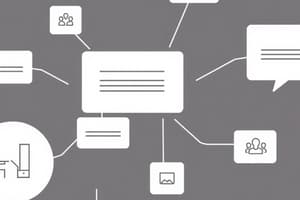Podcast
Questions and Answers
Design Thinking can best be described as a:
Design Thinking can best be described as a:
- Method for aesthetic design only.
- Rigid framework for problem-solving.
- Linear process for product development.
- Set of strategic, conceptual, and practical processes for developing design concepts. (correct)
Form, in design, refers only to the external appearance of an object, not its internal structure.
Form, in design, refers only to the external appearance of an object, not its internal structure.
False (B)
List the five stages of Design Thinking in the correct order.
List the five stages of Design Thinking in the correct order.
Empathize, Define, Ideate, Prototype, Test
The primary goal of the '________' stage in Design Thinking is to deeply understand the users' needs and challenges.
The primary goal of the '________' stage in Design Thinking is to deeply understand the users' needs and challenges.
Which of the following tools is LEAST likely to be used during the Design Thinking process?
Which of the following tools is LEAST likely to be used during the Design Thinking process?
Match the fundamental design element with its primary characteristic:
Match the fundamental design element with its primary characteristic:
Which type of line is most likely to convey a sense of stability and calmness in a design?
Which type of line is most likely to convey a sense of stability and calmness in a design?
Dots can only be used to create clustered areas of intensity in visual designs.
Dots can only be used to create clustered areas of intensity in visual designs.
Which type of shape is best described as precise, mathematical, and suggestive of order and structure?
Which type of shape is best described as precise, mathematical, and suggestive of order and structure?
Explain how diagonal lines contribute to the overall feel and impact of a design.
Explain how diagonal lines contribute to the overall feel and impact of a design.
A ______ is a two-dimensional area defined by boundaries, created by lines or color differences.
A ______ is a two-dimensional area defined by boundaries, created by lines or color differences.
Organic forms are typically associated with precise mathematical volumes and structured appearances.
Organic forms are typically associated with precise mathematical volumes and structured appearances.
In the design thinking process, what is the primary goal of the 'Empathize' stage?
In the design thinking process, what is the primary goal of the 'Empathize' stage?
The 'Define' stage of design thinking focuses on articulating a clear ______ based on user needs.
The 'Define' stage of design thinking focuses on articulating a clear ______ based on user needs.
During the 'Ideate' stage of design thinking, what is the primary goal?
During the 'Ideate' stage of design thinking, what is the primary goal?
In the 'Prototype' stage, perfection is prioritized over rapid iteration to ensure the final solution is flawless.
In the 'Prototype' stage, perfection is prioritized over rapid iteration to ensure the final solution is flawless.
What type of testing is commonly used in the 'Test' stage of design thinking to gather user feedback and refine solutions?
What type of testing is commonly used in the 'Test' stage of design thinking to gather user feedback and refine solutions?
Which technique is commonly used during the 'Ideate' stage to generate a wide array of innovative ideas?
Which technique is commonly used during the 'Ideate' stage to generate a wide array of innovative ideas?
When implementing design thinking to drive inventions, the first step involves ______ needs and challenges in specific domains.
When implementing design thinking to drive inventions, the first step involves ______ needs and challenges in specific domains.
Match the design thinking stage with its corresponding action in the context of driving inventions:
Match the design thinking stage with its corresponding action in the context of driving inventions:
Flashcards
Geometric Shapes
Geometric Shapes
Precise, mathematical shapes like circles, squares, and triangles, suggesting order and structure.
Organic Shapes
Organic Shapes
Natural, fluid shapes inspired by nature, suggesting growth and life.
Abstract Shapes
Abstract Shapes
Stylized, simplified representations of natural forms used to convey complex ideas.
Form
Form
Signup and view all the flashcards
Empathize
Empathize
Signup and view all the flashcards
Define
Define
Signup and view all the flashcards
Ideate
Ideate
Signup and view all the flashcards
Prototype
Prototype
Signup and view all the flashcards
Test
Test
Signup and view all the flashcards
Empathize (Invention)
Empathize (Invention)
Signup and view all the flashcards
Design Thinking
Design Thinking
Signup and view all the flashcards
Design Thinking Stages
Design Thinking Stages
Signup and view all the flashcards
Empathize (Design Thinking)
Empathize (Design Thinking)
Signup and view all the flashcards
Design Thinking Tools
Design Thinking Tools
Signup and view all the flashcards
Dot (Design element)
Dot (Design element)
Signup and view all the flashcards
Line (Design element)
Line (Design element)
Signup and view all the flashcards
Horizontal Lines
Horizontal Lines
Signup and view all the flashcards
Vertical Lines
Vertical Lines
Signup and view all the flashcards
Diagonal Lines
Diagonal Lines
Signup and view all the flashcards
Study Notes
- Design Thinking refers to strategic, conceptual, and practical processes for developing design concepts like product proposals, structures, equipment, and communications.
- Form is the three-dimensional aspect of a shape, creating volume and depth.
Five Stages of Design Thinking
- Empathize
- Define
- Ideate
- Prototype
- Test
Empathize
- Involves deeply understanding the people the design is for.
- Goals involve observing, engaging, and empathizing with users to uncover their needs, desires, and challenges.
- Can be achieved by conducting interviews or surveys and observing users in their environments.
Tools in Design Thinking
- Personas
- Customer journey maps
- Brainstorming
- Product Development
Fundamental Design Elements
- Dot: the most basic element of visual design, acting as a point in space and the start of visual communication.
- Smallest visual element is a characteristic of a dot.
- Dots create depth, texture, and movement.
- Dots draw attention, define boundaries, and create visual rhythm.
- Placement of dots can create clustered areas of intensity or sparse areas of minimal interaction, and directional flow of visual energy.
- Line: A continuous mark connecting 2 points, creating shape and form.
- Horizontal lines suggest stability and calmness and they represent calmness.
- Vertical lines imply strength and represent growth.
- Diagonal lines create dynamic tension and introduce energy and instability.
- Curved lines represent fluidity and convey softness and grace.
- Shape: A two-dimensional area defined by boundaries, created by lines or color differences.
- Geometric shapes are precise and mathematical, and they suggest order and structure.
- Organic shapes are natural, fluid forms inspired by nature and suggest growth and life.
- Abstract shapes are stylized representations that convey complex ideas through simplification.
- Form: The three-dimensional aspect of a shape, adding volume and depth.
- Geometric forms are precise mathematical volumes that are predictable and structured.
- Organic forms are irregular, natural shapes inspired by living organisms and are fluid and dynamic.
The Five Stages of Design Thinking
-
A structured approach to creative problem-solving, it aims to create innovative solutions by understanding users’ needs and experiences.
-
Popularized by the Hasso-Plattner Institute of Design at Stanford (d.school)
- Empathize: Understand the Users
- This stage focuses on gaining a deep understanding of the people being designed for
- Goals involve observing, engaging, and empathizing with users to uncover their needs, desires, and challenges.
- Set aside assumptions and rely on user insights. -Methods include: -Conducting interviews and surveys -Observing users in their environment -Creating empathy maps or user personas
- Outcome: A clear understanding of the users' experiences and pain points.
- Define: Clearly Articulate the Problem
- Insights from the empathize phase are synthesized to define a problem statement or point of view.
- Goals involve:
- Identifying the core problem to address, based on user needs.
- Framing the problem in a human-centered way.
- Methods include:
- Problem statements such as "How might we..." format.
- Journey mapping to understand user interactions and pain points.
- Outcome: A well-defined problem statement that guides the ideation process.
- Ideate: Generate Creative Solutions
- This stage encourages brainstorming to explore a wide range of potential solutions
- Goals:
- Generate as many ideas as possible, without judgment.
- Encourage creativity and consider unconventional solutions.
- Methods include:
- Brainstorming sessions
- Mind mapping
- SCAMPER (Substitute, Combine, Adapt, Modify, Put to another use, Eliminate, Reverse) -Outcome: A list of innovative ideas, ready to be prototyped and tested.
- Prototype: Build Tangible Models
- This stage is about creating simple, low-cost versions of the best ideas
- Goals are:
- transform ideas into tangible prototypes quickly
- identify strengths and weaknesses in the design quickly
- Methods include:
- Create physical models, digital mockups, or process diagrams
- Focus on rapid iteration rather than perfection.
- Outcome: A series of prototypes that provide insights into how the final solution might work.
- Test: Evaluate Solutions
- Prototypes are tested with real users to gather feedback and refine the solution
- Goals include:
- Observe how users interact with prototypes
- Identify areas for improvement and iterate on the design.
- Methods include:
- Usability testing
- A/B testing
- Collect qualitative and quantitative feedback
- Outcome: Refined solutions that address user needs effectively.
Implementing the Design Thinking Process in Driving Inventions
- Empathize: Identifying Needs and Challenges
- Goal: Understand the pain points, needs, and desires of potential users or industries.
- Actions:
- Observe real-world problems in specific domains
- Conduct interviews with stakeholders
- Research trends and gaps in existing solutions -Example: In transportation, observe challenges like traffic congestion or inefficiencies in public transit systems.
- Define: Framing the Problem
- Goal: Translate insights from the Empathize phase into a clear and actionable problem statement.
- Actions:
- Synthesize research to identify a specific, impactful problem.
- Create a "How Might We" (HMW) question to guide ideation.
- Ensure the problem statement is human-centered and focused on user outcomes.
- Example: "How might we reduce traffic congestion while promoting eco-friendly transportation?"
- Ideate: Generating Creative Solutions
- Goal: Brainstorm and explore a variety of inventive ideas.
- Actions:
- Encourage brainstorming sessions with diverse teams to generate many ideas.
- Use techniques like SCAMPER (Substitute, Combine, Adapt, Modify, Put to another use, Eliminate, Reverse).
- Explore unconventional approaches and emerging technologies.
- Example: Develop ideas for autonomous drones, modular carpooling systems, or solar-powered vehicles.
- Prototype: Building Tangible Models
- Goal: Create functional or conceptual prototypes to represent ideas.
- Actions:
- Build low-fidelity prototypes like sketches, models, or digital simulations.
- Test various materials, mechanisms, or software functionalities to validate feasibility.
- Keep prototypes simple and focused on demonstrating key features.
- Example: Create a 3D-printed model of a new drone design or a virtual prototype of a ride-sharing app.
- Test: Validating and Refining Solutions
- Goal: Gather feedback and refine the invention.
- Actions:
- Test prototypes with end-users in real-world settings.
- Collect qualitative and quantitative feedback on usability, effectiveness, and desirability.
- Iterate on the design based on insights and repeat testing as needed.
- Example: Test an autonomous drone's delivery capabilities in urban areas, refining its navigation system based on user feedback.
Studying That Suits You
Use AI to generate personalized quizzes and flashcards to suit your learning preferences.




